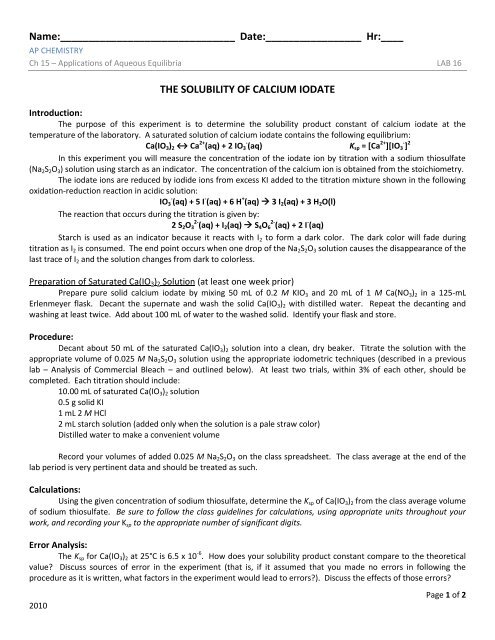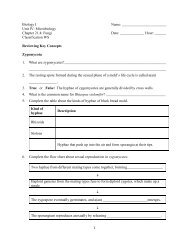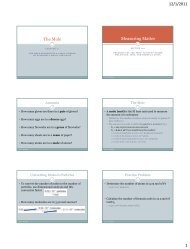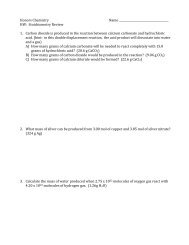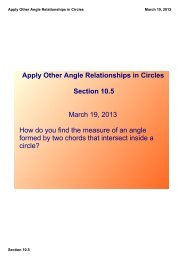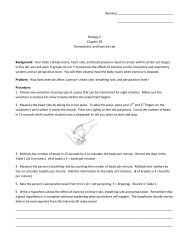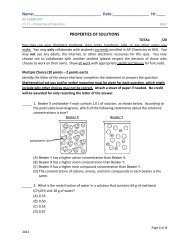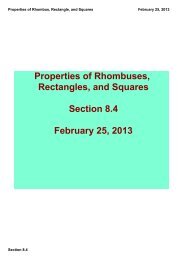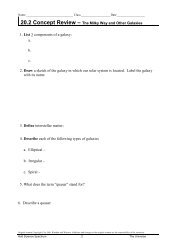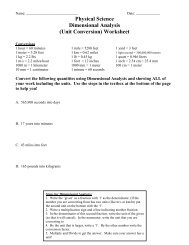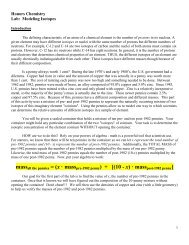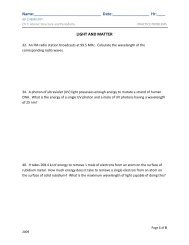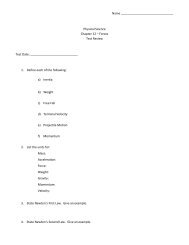Ksp PreLab for THURS - AP Chemistry
Ksp PreLab for THURS - AP Chemistry
Ksp PreLab for THURS - AP Chemistry
- No tags were found...
You also want an ePaper? Increase the reach of your titles
YUMPU automatically turns print PDFs into web optimized ePapers that Google loves.
Name:_______________________________ Date:_________________ Hr:____<strong>AP</strong> CHEMISTRYCh 15 – Applications of Aqueous Equilibria LAB 16THE SOLUBILITY OF CALCIUM IODATEIntroduction:The purpose of this experiment is to determine the solubility product constant of calcium iodate at thetemperature of the laboratory. A saturated solution of calcium iodate contains the following equilibrium:Ca(IO 3 ) 2 ↔ Ca 2+ (aq) + 2 IO 3 - (aq) K sp = [Ca 2+ ][IO 3 - ] 2In this experiment you will measure the concentration of the iodate ion by titration with a sodium thiosulfate(Na 2 S 2 O 3 ) solution using starch as an indicator. The concentration of the calcium ion is obtained from the stoichiometry.The iodate ions are reduced by iodide ions from excess KI added to the titration mixture shown in the followingoxidation-reduction reaction in acidic solution:IO 3 - (aq) + 5 I - (aq) + 6 H + (aq) 3 I 2 (aq) + 3 H 2 O(l)The reaction that occurs during the titration is given by:2 S 2 O 3 2- (aq) + I 2 (aq) S 4 O 6 2- (aq) + 2 I - (aq)Starch is used as an indicator because it reacts with I 2 to <strong>for</strong>m a dark color. The dark color will fade duringtitration as I 2 is consumed. The end point occurs when one drop of the Na 2 S 2 O 3 solution causes the disappearance of thelast trace of I 2 and the solution changes from dark to colorless.Preparation of Saturated Ca(IO 3 ) 2 Solution (at least one week prior)Prepare pure solid calcium iodate by mixing 50 mL of 0.2 M KIO 3 and 20 mL of 1 M Ca(NO 3 ) 2 in a 125-mLErlenmeyer flask. Decant the supernate and wash the solid Ca(IO 3 ) 2 with distilled water. Repeat the decanting andwashing at least twice. Add about 100 mL of water to the washed solid. Identify your flask and store.Procedure:Decant about 50 mL of the saturated Ca(IO 3 ) 2 solution into a clean, dry beaker. Titrate the solution with theappropriate volume of 0.025 M Na 2 S 2 O 3 solution using the appropriate iodometric techniques (described in a previouslab – Analysis of Commercial Bleach – and outlined below). At least two trials, within 3% of each other, should becompleted. Each titration should include:10.00 mL of saturated Ca(IO 3 ) 2 solution0.5 g solid KI1 mL 2 M HCl2 mL starch solution (added only when the solution is a pale straw color)Distilled water to make a convenient volumeRecord your volumes of added 0.025 M Na 2 S 2 O 3 on the class spreadsheet. The class average at the end of thelab period is very pertinent data and should be treated as such.Calculations:Using the given concentration of sodium thiosulfate, determine the K sp of Ca(IO 3 ) 2 from the class average volumeof sodium thiosulfate. Be sure to follow the class guidelines <strong>for</strong> calculations, using appropriate units throughout yourwork, and recording your K sp to the appropriate number of significant digits.Error Analysis:The K sp <strong>for</strong> Ca(IO 3 ) 2 at 25°C is 6.5 x 10 -6 . How does your solubility product constant compare to the theoreticalvalue? Discuss sources of error in the experiment (that is, if it assumed that you made no errors in following theprocedure as it is written, what factors in the experiment would lead to errors?). Discuss the effects of those errors?2010Page 1 of 2
Name:_______________________________ Date:_________________ Hr:____<strong>AP</strong> CHEMISTRYCh 15 – Applications of Aqueous Equilibria LAB 16THE SOLUBILITY OF CALCIUM IODATEGrading RubricItemHEADINGS ON EACH PAGETitle of ExperimentDate Experiment StartedSuccessive Page NumbersName & PartnerPointsDATA SHEETAppropriate Purpose /3Clear & Complete Procedure /7Procedure Initialed by Instructor /1Clear & Complete Data and Observations /3WRITE UPClear & Complete Pertinent Data /2Clear & Complete Sample Calculations Present /8Clear & Complete Error AnalysisSources of Error/4Effects of ErrorsClear & Complete Conclusion /2TOTAL /302010Page 2 of 2


